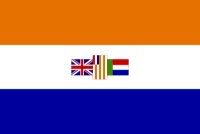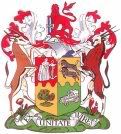South Africa
From Kaiserreich
m (→History) |
m (→Navy and Air Force) |
||
| Line 78: | Line 78: | ||
=== Navy and Air Force === | === Navy and Air Force === | ||
| - | When the British fleet was recalled to [[Canada]] in 1930, the coasts of South Africa were left undefended. Since then, only one light cruiser has been purchased and a handful of destroyers were built, but the military and the government had to face the fact that they | + | When the British fleet was recalled to [[Canada]] in 1930, the coasts of South Africa were left undefended. Since then, only one light cruiser has been purchased and a handful of destroyers were built, but the military and the government had to face the fact that they did not have the funds to have a serious naval program to protect the country from external threats. There is no air-force and there are no serious plans for creating one. |
== Foreign Relations == | == Foreign Relations == | ||
Revision as of 18:49, 29 April 2011
| ||||||
| Motto Ex Unitate Vires | ||||||
| Official Language | English, Afrikaans | |||||
| Capital | Pretoria | |||||
| Head of State | Jan Smuts | |||||
| Head of Government | Jan Hendrik Hofmeyr | |||||
| Establishment - South Africa Act 1909 | May 31 1910 | |||||
| Government | Semi-presidential republic | |||||
| Currency | South African pound | |||||
| Area | Around 1.850.000 km² | |||||
| Population | Around 10 million | |||||
South Africa is a country in Africa. It is bordered by Mittelafrika to the north-west and the Portuguese colony of Mozambique to the north-east.
Contents |
History
For thousands of years South Africa has been populated by two distinct cultural groups: the hunter gatherer San (Bushmen) and the agrarian Khoikhoi (Hottentots). These communities were irretrievably shattered by the arrival, in 1652, of Dutch bases on the cape, which were quickly followed by settlements. The Khoikhoi were soon reduced to forced labor for the settlers and for the Dutch East India Company, with rights often much less than that of slaves in the Americas. After the British took control of the colony during the Napoleonic Wars several attempts were made to alleviate the plight of the Khoikhoi, with limited success. Either way the liberal policies of the British led to large numbers of Dutch Voortrekkers to head north and establish their own republics on still more Khoikhoi land. The interior of South Africa would remain largely unsettled by whites, however, well into the 19th century. This would all change upon the discovery of vast diamond and gold deposits in the area. The influx of British prospectors would soon lead to increasingly violent confrontations between British colonials and Boer Republicans. The period also saw the final, violent repressions of the last remaining free chiefdoms in South Africa. An attempt at a federal system incorporating both the colonies and the Boer republics was shattered by a Boer victory over the British at Majuba in 1881. The resulting Second Boer War, which raged from 1899-1902, would lead to an annexation of the Boer republics. The Boers, however, would win the peace, creating a constitution that ensured the retention of white-only rule in South Africa. White Boers still, however, held a great deal of resentment towards the British Empire.
During the Weltkrieg South African troops invaded German South-West Africa and by July 1915 occupied every part of it. However, by the agreements of the 1921 Peace With Honour, they had to return it to Germany. On December 27, 1922 the British colony of Southern Rhodesia was incorporated into South Africa after a referendum where the Southern Rhodesian electorate, nervous of potential German expansionism in the region, voted by a narrow margin to join the Union of South Africa. Following the events of the 1925 British Revolution South African troops quickly occupied the British Bechuanaland Protectorate as well as the Basutoland and Swaziland protectorates, but South Africa had to leave the other African regions of the British Empire in German hands (most of which were later included in Mittelafrika).
The 1921 South African general election saw the South African Party lead by Jan Smuts achieve an absolute majority. However, in 1924 the rising discontent with his government led to his defeat by a coalition of the pro-Afrikaner National Party and the socialist South African Labour Party. James Hertzog, the leader of the National Party and once a Boer general, became the new President of South Africa. Hertzog encouraged the development of the Afrikaner culture and was determined to protect the Afrikaner from British influence. This led to increasing tension between the Union of South Africa and the rest of the British Empire.
In the 1929 election the National Party under James Hertzog won an outright majority, which enabled Hertzog to form a government without the aid of the Labour Party and for the National Party to rule for its second consecutive term. In 1930 the decision of the newly formed conservative government of Canada, led by Sir R.B. Bennett, to recall the entire South African Station of the British Fleet caused great resentment in the Union of South Africa. In 1932 Hertzog succeeded in making South Africa a republic, although this was deeply unpopular with many people especially in Natal and Rhodesia, with some observers saying that fear of the Germans was the only thing which prevented the situation from spiraling into civil war. However, the increasing menace posed by Freistaat Mittelafrika and accusations of corruption brought down the trust in the government. In the 1933 election the newly created United Party (born from the union of the South African Party, the Unionist Party and other lesser parties) won a non-absolute majority and formed a minority government led once again by Jan Smuts. The United party worked for a reconciliation with the Royal Family and the Entente, but the opposition of the National Party prevented any serious action in that direction.
Politics
In the 1933 South African general election the United Party led by Jan Smuts received more votes than the National Party led by James Hertzog and the Labour Party led by William Andrews, but did not achieve an absolute majority and was therefore forced to form a minority government. New elections are scheduled for May 1938 and as of now it is impossible to predict who the people will chose.
Head of State: Jan Smuts
Head of Government: Jan Hendrik Hofmeyr
Foreign Minister: Jan Smuts
Minister of Armament: Jan Hendrik Hofmeyr
Minister of Security: Nicolaas Jacobus de Wet
Minister of Intelligence: Jan Smuts
Chief of Staff: Pierre van Ryneveld
Chief of Army: James Mitchell-Baker
Chief of Navy: Pierre Oliver-Knoll
Chief of Air Force: Pierre van Ryneveld
Military
Army
South Africa has a small army, for defence purposes, consisting in 3 division located in Cape Town, Johannesburg and Durban (the latter two only at half strenght). However, there are rumours about a possible expansion of the army in the future, as part of the military would like to take the initiative and expand the borders of South Africa at the expenses of its neighbours.
Navy and Air Force
When the British fleet was recalled to Canada in 1930, the coasts of South Africa were left undefended. Since then, only one light cruiser has been purchased and a handful of destroyers were built, but the military and the government had to face the fact that they did not have the funds to have a serious naval program to protect the country from external threats. There is no air-force and there are no serious plans for creating one.
Foreign Relations
Very good relations and with Canada and Australasian Confederation. Both countries also grant military access to South Africa.
Friendly relations with Portugal and Mittelafrika.
Unfriendly relations with Abyssinia.
Culture
The victory of the pro-Afrikaner National Party in the 1924 elections was very important for the development of the Afrikaner culture. Afrikaans replaced Dutch as the second official language of South Africa (with English) on 5 May 1925. Since then, the Afrikaner language and culture gained more and more importance.


